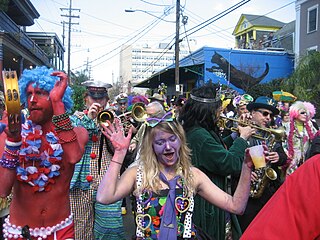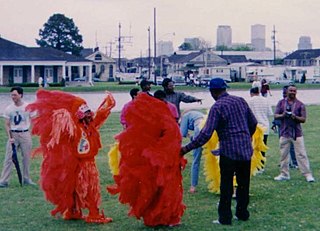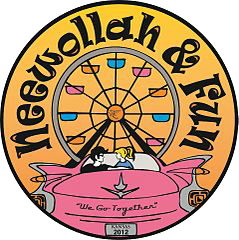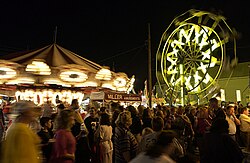
A parade is a procession of people, usually organized along a street, often in costume, and often accompanied by marching bands, floats, or sometimes large balloons. Parades are held for a wide range of reasons, but are usually celebrations of some kind.

Mardi Gras refers to events of the Carnival celebration, beginning on or after the Christian feasts of the Epiphany and culminating on the day before Ash Wednesday, which is known as Shrove Tuesday. Mardi Gras is French for "Fat Tuesday", reflecting the practice of the last night of eating rich, fatty foods before the ritual Lenten sacrifices and fasting of the Lenten season.

Carnival is a Christian festive season that occurs before the liturgical season of Lent. The main events typically occur during February or early March, during the period historically known as Shrovetide. Carnival typically involves public celebrations, including events such as parades, public street parties and other entertainments, combining some elements of a circus. Elaborate costumes and masks allow people to set aside their everyday individuality and experience a heightened sense of social unity. Participants often indulge in excessive consumption of alcohol, meat, and other foods that will be forgone during upcoming Lent. Traditionally, butter, milk, and other animal products were not consumed "excessively", rather, their stock was fully consumed during Shrovetide as to reduce waste. This festival is known for being a time of great indulgence before Lent, with drinking, overeating, and various other activities of indulgence being performed. For example, pancakes, donuts, and other desserts are prepared and eaten for a final time. During Lent, lacticinia and animal products are eaten less, and individuals make a Lenten sacrifice, thus giving up a certain object or activity of desire.

The Sydney Gay and Lesbian Mardi Gras or Sydney Mardi Gras is an event in Sydney, New South Wales attended by hundreds of thousands of people from around Australia and overseas. One of the largest such festivals in the world, Mardi Gras is the largest Pride event in Oceania. It includes a variety of events such as the Sydney Mardi Gras Parade and Party, Bondi Beach Drag Races, Harbour Party, the academic discussion panel Queer Thinking, Mardi Gras Film Festival, as well as Fair Day, which attracts 70,000 people to Victoria Park, Sydney.

The Mistick Krewe of Comus, founded in 1856, is the oldest extant New Orleans, Louisiana Carnival Krewe, the longest to continually parade with few interruptions from 1856 to 1991, and continues to hold a tableau ball for its members and guests, to date. Initially its public facade was The Pickwick Club.

Rex is a New Orleans Carnival Krewe which stages one of the city's most celebrated parades on Mardi Gras Day. Rex is Latin for "King", and Rex reigns as "The King of Carnival".

The holiday of Mardi Gras is celebrated in southern Louisiana, including the city of New Orleans. Celebrations are concentrated for about two weeks before and through Shrove Tuesday, the day before Ash Wednesday. Mardi Gras is French for Fat Tuesday, the season is known as Carnival and begins on King's Day, January 6(changes yearly with the church calendar), and extends until midnight before Ash Wednesday. Club, or Krewe, balls start soon after, though most are extremely private, with their Kings and Queens coming from wealthy old families and their courts consisting of the season's debutantes. Most of the high society Krewes do not stage parades. As Fat Tuesday gets nearer, the parades start in earnest. Usually there is one major parade each day ; many days have several large parades. The largest and most elaborate parades take place the last five days of the Mardi Gras season. In the final week, many events occur throughout New Orleans and surrounding communities, including parades and balls.

Mardi Gras Indians are African American carnival revelers in New Orleans, Louisiana, who dress up for Mardi Gras in suits influenced by Native American ceremonial apparel.

Fantasy Fest is a street party held annually in the last week of October in Key West, Florida.
Carnival Memphis, is a series of parties and festivals staged annually since 1931 in Memphis, Tennessee by the centralized Carnival Memphis Association and its member krewes during the month of June. Carnival salutes various aspects of Memphis and its industries, and is reigned over by current year's secretly selected King, Queen, and Royal Court of Carnival.

Neewollah Festival is an annual festival during the last week of October, in Independence, Kansas.

Mardi Gras is the annual Carnival celebration in Mobile, Alabama. It is the oldest official Carnival celebration in the United States, started by Frenchman Nicholas Langlois in 1703 when Mobile was the capital of Louisiana. Although today New Orleans and South Louisiana celebrations are much more widely known for all the current traditions such as masked balls, parades, floats and throws were first created there. From Mobile being the first capital of French Louisiana (1702), the festival began as a French Catholic tradition. Mardi Gras has now evolved into a mainstream multi-week celebration across the spectrum of cultures, becoming school holidays for the final Monday and Tuesday, regardless of religious affiliation.

The Courir de Mardi Gras is a traditional Mardi Gras event held in many Cajun and Creole communities of French Louisiana on the Tuesday before Ash Wednesday. Courir de Mardi Gras is Louisiana French for "Fat Tuesday Run". This rural Mardi Gras celebration is based on early begging rituals, similar to those still celebrated by mummers, wassailers, and celebrants of Halloween. As Mardi Gras is the celebration of the final day before Lent, celebrants drink and eat heavily, dressing in specialized costumes, ostensibly to protect their identities. In Acadiana, popular practices include wearing masks and costumes, overturning social conventions, dancing, drinking alcohol, begging, trail riding, feasting, and whipping. Mardi Gras is one of the few occasions when people are allowed to publicly wear masks in Louisiana. Dance for a Chicken: The Cajun Mardi Gras, a documentary by filmmaker Pat Mire, provides great insight into the history and evolution of this cultural tradition. In popular culture, two HBO series also make reference to the tradition.

A mystic society is a Mardi Gras social organization in Mobile, Alabama, that presents parades and/or balls for the enjoyment of its members, guests, and the public. The New Orleans Krewe is patterned after Mobile's Mystics. The societies have been based in class, economic and racial groups. Mobile's parading mystic societies build colorful Carnival floats and create costumes around each year's themes.

Mardi Gras in the United States is not observed nationally across the country, largely due to the country's Protestant and Anglo-Saxon roots. Mardi Gras and Carnival are mostly Catholic holidays, while the United States has a Protestant-majority population. However, a number of cities and regions in the U.S. have notable Mardi Gras or Carnival celebrations. Most of these places trace their Mardi Gras celebrations to French, Spanish, and other Catholic colonial influences on the settlements over their history. The earliest Carnival celebration in North America occurred at a place on the west bank of the Mississippi River about 60 miles (97 km) downriver from where New Orleans is today; this Mardi Gras on March 3, 1699, and in honor of this holiday, Pierre Le Moyne, Sieur d'Iberville, a 38-year-old French Canadian, named the spot Point du Mardi Gras near Fort Jackson. The earliest organized Carnival celebrations occurred in Mobile, then the capitol of French Louisiana known as Fort Louis de la Mobile, where in 1704 the first known Carnival secret society. In 1856, six Mobile natives established the first secret society, or krewe, in New Orleans, the Mistick Krewe of Comus. Former French and Spanish colonies such as Pensacola, Biloxi, and settlements along the Gulf Coast all followed suit in incorporating Carnival into their annual celebrations, which today have developed either separate traditions or variations of them from one another. In addition, modern activities generally vary from city to city across the U.S.
Haitian Carnival is a celebration held over several weeks each year leading up to Mardi Gras. Haitian Defile Kanaval is the Haitian Creole name of the main annual Mardi Gras carnival held in Port-au-Prince, Haiti.
Krewe of Carrollton is a New Orleans Mardi Gras krewe.
Knights of Babylon is a New Orleans Mardi Gras krewe that was founded in 1939.















